PSCs & Ozone Holes- OPOD
PSCs & Ozone Holes: A Closer Look at the Connection
Polar Stratospheric Clouds (PSCs) have recently made headlines due to their association with ozone holes. These unique cloud formations, which occur in the stratosphere, have the potential to wreak havoc on our ozone layer. In this article, we will delve deeper into the different types of PSCs and their impact on the ozone layer, shedding light on this fascinating atmospheric phenomenon.
Unraveling the Mystery of PSCs
PSCs come in various types, but it is the Type II, known as nacreous clouds, that capture our attention with their dazzling iridescence. Composed of tiny ice crystals, nacreous clouds are relatively harmless. On the other hand, Type I PSCs pose a greater concern. These clouds consist of minuscule droplets of nitric and sulfuric acids. While it may seem counterintuitive, these clouds are entirely natural, yet they interact with human-made chemicals present in our atmosphere.
The Ozone Depletion Connection
Type I PSCs play a significant role in the depletion of the stratospheric ozone layer, which shields us from harmful ultraviolet radiation. The acid droplets present in these clouds act as catalysts, transforming otherwise unreactive forms of man-made chlorine into highly reactive free radicals, such as chlorine monoxide (ClO). These radicals initiate a chain reaction that results in the destruction of numerous ozone molecules. Additionally, Type I clouds remove gaseous nitric acid from the stratosphere, preventing it from combining with ClO and forming less reactive forms of chlorine.
The UK/Ireland Ozone Hole
A recent episode of rare PSCs over Ireland and the UK brought attention to the impact of these clouds on the ozone layer. The images captured during this event revealed extensive Type I (acid droplet) and some Type II (nacreous ice) stratospheric clouds. The presence of Type I clouds over the region has led to the formation of an ozone hole, highlighting the destructive potential of these atmospheric phenomena.
PSC Sightings Beyond Expectations
PSCs are typically observed in polar regions due to the low temperatures necessary for their formation. However, there have been sightings of these clouds in unexpected locations. For instance, the French Alps experienced a dawn sighting of PSCs on February 1st, showcasing the presence of these clouds further south than usual. The stratospheric temperature in the area was low enough to facilitate their formation. Similarly, sightings in the Netherlands on the afternoon and evening of February 2nd confirmed the occurrence of predominantly Type I (acid) PSCs.
The Ongoing Research Efforts
The study of PSCs and their impact on the ozone layer is an active field of research. Scientists are continuously working to deepen our understanding of these atmospheric optics phenomena and their implications for our environment. By investigating the factors that contribute to PSC formation and studying their interaction with man-made chemicals, researchers aim to develop strategies to mitigate their harmful effects on the ozone layer.
Conclusion
Polar Stratospheric Clouds (PSCs) hold both intrigue and concern due to their association with ozone holes. While nacreous clouds showcase nature's artistic side, it is the Type I PSCs that pose a threat to our protective ozone layer. By catalyzing the destruction of ozone molecules through chain reactions, these acid droplet clouds contribute to the formation of ozone holes. As we continue to unravel the complexities of PSCs and their impact, ongoing research endeavors strive to find ways to safeguard our ozone layer and protect our planet from harmful ultraviolet radiation.
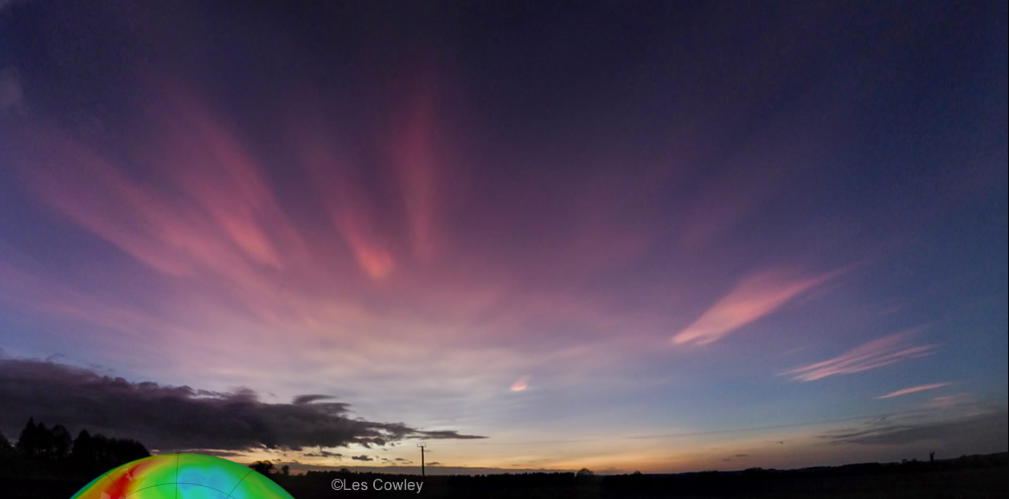

The UK/Ireland Ozone Hole ~ The episode of rare polar stratospheric clouds (PSCs) over Ireland and UK started on 31st January and has so far lasted three days. The picture above was taken after sunset on 2nd February and shows extensive Type I (acid droplet) and some Type II (nacreous ice) stratospheric cloud. More pictures are below – earlier images here 1,2,3.
PSCs come in several types. Only Type II (nacreous) are the bright and strongly iridescent ones. Nacreous clouds are tiny ice crystals and are fairly benign. Type I PSCs are another matter! They are very small droplets of nitric and sulphur acids. Strange as it seems, these clouds are completely natural. But they act on chemicals that we emit into the air.
The acid droplets destroy the stratospheric ozone layer that protects us from harmful solar ultra-violet rays. They catalyse unreactive forms of man-made chlorine into active free radicals (for example ClO, chlorine monoxide). The radicals destroy many ozone molecules in a series of chain reactions. Type I clouds also remove gaseous nitric acid from the stratosphere which would otherwise combine with ClO to form less reactive forms of chlorine.
The Type I clouds have produced an ozone hole over UK/Ireland
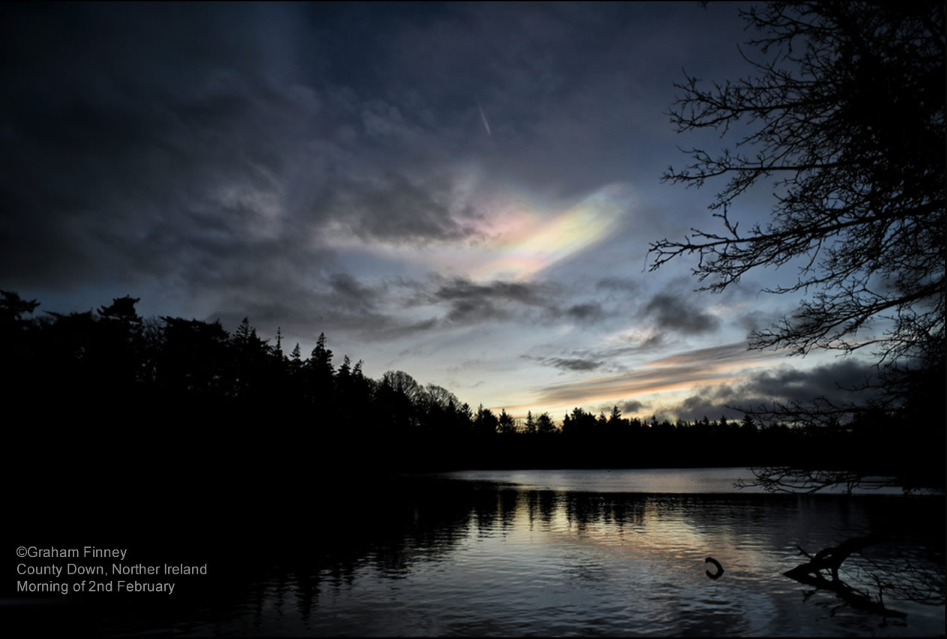

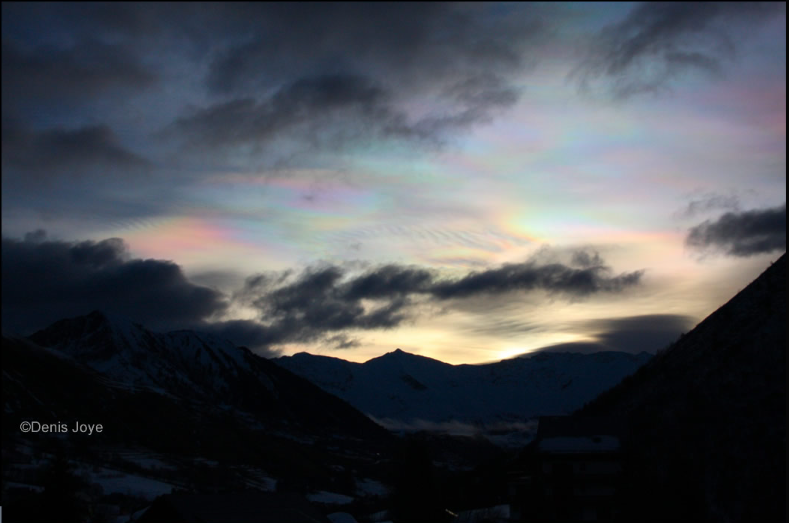
French Alps
Dawn on Feb 1st.
Far south for PSCs but the stratospheric temperature there was low enough for them to form.
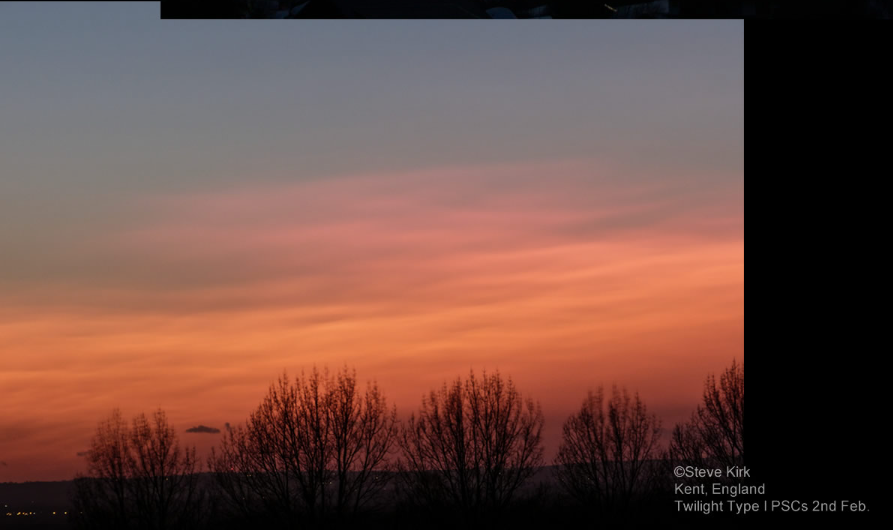

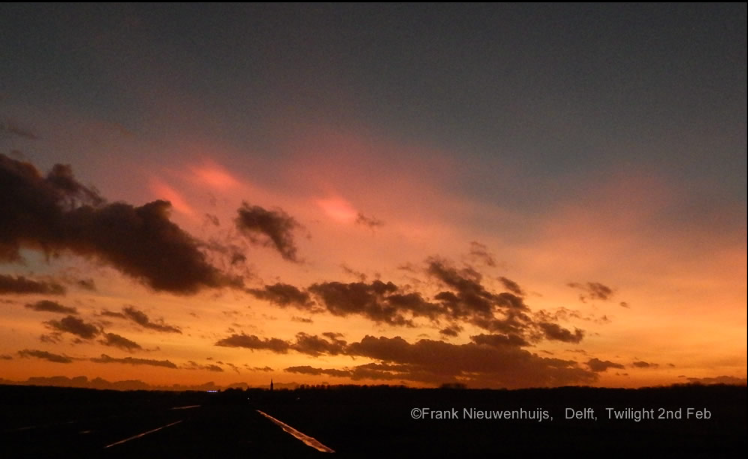
Sightings in The Netherlands afternoon and evening of 2nd February.
At left the scene suggests predominantly Type I (acid) PSCs as in the topmost image.

Daytime

Another daytime sighting at Deventer in The Netherlands.

Note: this article has been automatically converted from the old site and may not appear as intended. You can find the original article here.
Reference Atmospheric Optics
If you use any of the definitions, information, or data presented on Atmospheric Optics, please copy the link or reference below to properly credit us as the reference source. Thank you!
-
<a href="https://atoptics.co.uk/blog/pscs-ozone-holes-opod/">PSCs & Ozone Holes- OPOD</a>
-
"PSCs & Ozone Holes- OPOD". Atmospheric Optics. Accessed on December 17, 2024. https://atoptics.co.uk/blog/pscs-ozone-holes-opod/.
-
"PSCs & Ozone Holes- OPOD". Atmospheric Optics, https://atoptics.co.uk/blog/pscs-ozone-holes-opod/. Accessed 17 December, 2024
-
PSCs & Ozone Holes- OPOD. Atmospheric Optics. Retrieved from https://atoptics.co.uk/blog/pscs-ozone-holes-opod/.